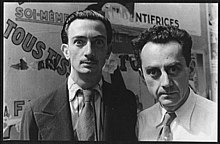Minotaure
[1][2][3] The review was originally founded by E. Tériade (Stratis Eleftheriadis) and Albert Skira with the desire to produce a lavish magazine on "The plastic arts - poetry - music - architecture - ethnography and mythology - theater - psychoanalytical studies and observations.
"[3] Although not intended to be strictly a surrealist review, Albert Skira had been associating with André Breton and others in the movement and invited their input, even before the first issue was published.
[2] The original editor was E. Tériade, but that role was soon taken over by Skira, who formed an editorial committee that included André Breton, Marcel Duchamp, Paul Eluard, Maurice Heine, and Pierre Mabille [fr], giving it a heavy surrealist bias early on.
Breton had virtually taken over editorship of Minotaure by the 1939 issue, however his tenure was short lived with the outbreak of World War II, an exodus of surrealists to the United States, and Albert Skira's return to Switzerland in the following months.
[3][4][5][6][7] The name Minotaure is attributed to Georges Bataille and André Masson, suggested "during a meeting with [Roger] Vitrac, [Robert] Desnos, and E. Tériade, who were in favor of calling the review L'Age d'Or.
[3][8] Minotaure was a luxurious review in its day, featuring original artworks on the cover by prominent artists like Matisse, Picasso, Duchamp, Miró, and Dalí, and it grew more lavish with each passing year.
With an international circulation in several European counties, the journal was a significant element in Surrealism's rise from a relatively obscure circle of poets, artist, and intellectuals in the 1920s to a major movement of twentieth century art.
Maurice Heine [fr], one of the editorial committee members, was a major figure in rediscovering and publishing the work of the Marquis de Sade and he produced articles for most volumes of Minotaure.
The participation of E. Tériade added a significant dimension to Minotaure, with contributions in most of the issues on art and artist beyond the surrealist movement, like Matisse and Fauvism.
Surrealist views on architecture were presented in articles by Tristan Tzara, "D'un certain automatisme du goût", Salvador Dalí, "De la beauté terrifiante et comestible, de l'architecture Modern' style", and Roberto Matta, "Mathématiques sensibles - Architecture du Temps".
[1][2][3][4][5][6][7] Several important artists of the twentieth century received some of their earliest, or first recognition in Minotaure like Hans Bellmer and his doll, Victor Brauner, Paul Delvaux, Alberto Giacometti, Roberto Matta, Kurt Seligmann, and Frida Kahlo.
Many important photographers contributed regularly or were featured in the journal including Bill Brandt, Brassai, Dora Maar, Man Ray, and Raoul Ubac.
Other diverse and unexpected figures such as Le Corbusier, André Derain, and Ambroise Vollard all contributed articles at one time or another, as did composers Kurt Weill and Igor Markevitch.
[1][2][3][4][5][6][7] Physician and writer Pierre Mabille [fr], with expertise on anthropology, sociology and medicine was on the editorial committee and contributed articles to many of the volumes.
Concordantly, Minotaure kept an "open house to the essays"[4] from a wide range of philosophers, psychologists, anthropologist, historians, and other specialists including Jean Wahl, Roger Caillois, Pierre Courthion, and Michel Leiris.
The entire second issue was devoted to Mission Dakar-Djibouti [fr], an expedition to Africa commissioned by the French state and conducted by the Musée d'Ethnographie du Trocadéro under the direction of Marcel Griaule from 1931 to 1933.
Paul Eluard, Par un apré-midi trés froid des preniers jours de 1713 ou le Monde tel qu'il est [By a Very Cold Afternoon of the First Days of 1713 or the World As It Is].
Color reproduction of the Epinal image "La Folie des Hommes ou le monde à rebours" [The Madness of Men or the World Backwards].
René Crevel, La grande mannequin cherche et trouve sa peau [The Great Model is Looking for and Finding Her Skin].
Reproductions of paintings, sculptures and drawings by Balthus, Beaudin, Borés, Braque, Dalí, Ernst, Gargallo, Giacometti, Huf, Klee, Laurens, Lipchitz, Manés, Miro, Picasso, Rattner, Roger, Roux, and Tanguy.
Cover by Marcel Duchamp: D Pierre Mabille [fr], Prèface à l'éloge des préjugés populaires [Preface to the eulogy of popular prejudices].
Paul Éluard, Physique de la Poésie [Physics of Poetry], Blake, Goethe (Delacroix), Arnim, (Valentine Hugo), La motte-Fougué, (Rackham), Borel, Poe, (Manet), Baudelaire, (Redon), Lautreamont, (Dalí), Carroll, Nouveau (Rodin), Mallarmé, (Rops, Renoir, Matisse), Maeterlinck, (Minne), Apollinaire, (Picasso, Rouveeyre), Reverdy, (Derain, Matisse), Breton (Derain), Tzara, (Arp, Klee), Eluard, (Ernst, Tanguy), Péret, (Picasso), Char, (Kandinsky).
Paul Valéry, Réflexion sur le paysage et vien d'autres choses [Reflection on the Landscape and Other Things].
Avec seize reproductions en fac-similé des empreintes de mains d'écricvains et d'artistes contemporains [Psychic Revelations of the Hand.
Maurice Heine [fr], Nuits romantiques sous le Roi Soleil [Romantic Nights Under the Sun King].
Reproduction of Surrealist Documents] Reproduction of works from Hans Arp, Hans Bellmer, Victor Brauner, Serge Brignoni, Cornell, Salvador Dalí, Paul Delvaux, Oscar Dominguez, Marcel Duchamp, Espinoza, Max Ernst, Georges Hugnet, René Magritte, Juan Miro, Henry Moore, Paul Nash, Wolfgang Paalen, Roland Penrose, Remedios Varo, Kurt Seligmann, J. Styrsky, and Yves Tanguy.
Jean Cazaux, Révolte et docilité dans l'invention poétique surréaliste [Revolt and Docility in Surrealist Poetic Invention].
Paul Recht, L'homme qui perd son ombre [The Man Who Loses His Shadow], photography by Brassai, after Jacques Berthier.
Paintings by Hans Arp, Max Ernst, Yves Tanguy, Wolfgang Paalen, Ecole de Botticelli, Piero di Cosimo, Bartolomeo Veneto.
André Breton, Des tendances les plus récentes de la peinture surréaliste [The Most Recent Tendencies in Surrealist Painting].


